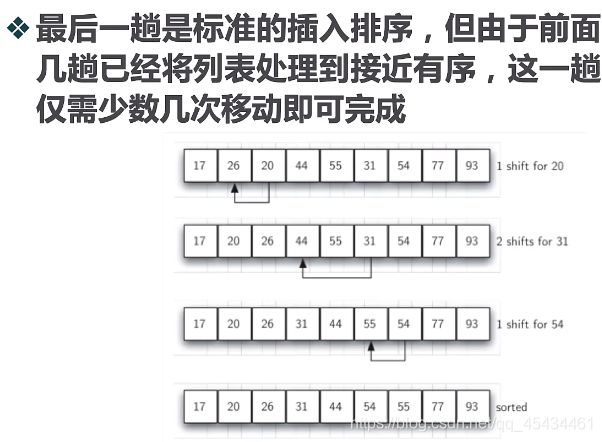基于python的数据结构和算法(北京大学)第七章(排序和查找)
- 顺序查找Sequential Search:
无序表顺序查找:
def sequentialSearch(alist,item):
pos = 0
found = False
while pos有序表顺序查找:
def orderedSequentialSearch(alist,item):
pos = 0
found = False
stop = False
while pos item:
stop = True
else:
pos += 1
return found
关键在于有序时,加入stop参数来控制循环,当出现第一个比所查找目标大的数时,即不必查找后面的数,可直接进入下一轮循环,这样可以有效降低查找的时间复杂度。
- 二分查找:
二分查找主要应用于有序表,每次都查找当前部分有序表的中间值进行比较。由于为有序表,比较非相等之后,便可根据比较的大小,进入左侧或右侧的部分有序表进行再次取中间值对比。
非递归实现:
def binarySearch(alist,item):
first = 0
last = len(alist)-1
found = False
while first<=last and not found:
midpoint = (first+last)/2
if alist[midpoint]==item:
found = True
else:
if item递归实现:
def binarySearch(alist,item):
if len(alist) == 0:
return False
else:
midpoint = len(alist)/2
if alist[midpoint] == item:
return True
else:
if item- 冒泡排序:
冒泡排序算法的思路在于对无序表进行多趟比较交换。每趟包括了多次两两相邻比较,并将逆序的数据项交换位置,最终能将本趟的最大项就位。经过n-1趟比较,实现整表排序。每趟的过程类似“气泡”在水上不断上浮到水面的过程。
def bubbleSort(alist):
for passnum in range(len(alist)-1,0,-1):
for i in range(passnum):
if alist[i]>alist[i+1]:
temp = alist[i]
alist[i] = alist[i+1]
alist[i+1] = temp # <=> alist[i],alist[i+1] = alist[i+1],alist[i]
对于冒泡排序,冒泡排序时间效率较差,复杂度为O(n^2)。但无需任何额外的存储空间开销。
算法过程总需要n-1趟,随着趟数的增加,比对的次数逐步从n-1减少到1,并包括可能发生的数据项交换。因此,比对的次数为1 – n-1 的累加,为1/2n^2 - 1/2n。
最好的情况为列表在排序前已经有序,交换次数为0,最差的情况是每次比对都要进行交换,交换次数等于比对次数。平均情况为最差情况的一半。
冒泡排序通常作为时间效率较差的排序算法,来作为其他算法的对比基准。
- 对冒泡排序算法的改进,可以通过监测每趟比对是否发生过交换,可以提前确定排序是否完成。如果某趟比对没有发生任何交换,说明列表已经排好序,可以提前结束算法。
def shortBubbleSort(alist):
exchange = True
passnum = len(alist)-1
while passnum > 0 and exchange:
exchange = False
for i in range(passnum):
if alist[i]>alist[i+1]:
exchange = True
alist[i],alist[i+1] = alist[i+1],alist[i]
passnum = passnum-1
- 选择排序(Selection Sort)
选择排序对冒泡排序进行了改进,保留了其基本的多趟比对思路,每趟都使当前最大项就位。但是选择排序对交换进行了削减,相比起冒泡排序进行多次交换,每趟仅进行一次交换,记录最大项所在位置,最后再跟本趟最后一项交换。在时间复杂度上,比冒泡稍优。对比次数不变,O(n^2)。而交换次数则减少为了O(n)。
重复(元素个数-1)次
选择排序的过程为:
把第一个没有排序过的元素设置为最小值
遍历每个没有排序过的元素
如果元素 < 现在的最小值
将此元素设置成为新的最小值
将最小值和第一个没有排序过的位置交换
def selectionsort(alist):
for i in range(len(alist)):
minindex = i
for j in range(i,(len(alist))):
if alist[j] < alist[minindex]:
minindex = j
temp = alist[i]
alist[i] = alist[minindex]
alist[minindex] = temp
return alist
print(selectionsort([1,5,7,3,7,0,2,8,3,99,44,35]))
标准代码
def selectionSort(alist):
for fillslot in range(len(alist)-1,0,-1):
positionOFMAX = 0
for location in range(1,fillslot+1):
if alist[location]>alist[positionOFMAX]:
positionOFMAX = location
temp = alist[fillslot]
alist[fillslot] = alist[positionOFMAX]
alist[positionOFMAX] = temp
- 插入排序(Insertion Sort)
插入排序时间复杂度仍然是O(n^2),但思路有所变化。
插入排序维持一个已排好序的子列表,其位置始终在列表的前部,然后逐步扩大这个子列表直到全表。
算法过程:
将第一个元素标记为已排序
遍历每个没有排序过的元素
“提取” 元素 X
i = 最后排序过元素的指数 到 0 的遍历
如果现在排序过的元素 > 提取的元素
将排序过的元素向右移一格
否则:插入提取的元素
def insertionSort(alist):
for index in range(1,len(alist)):
currentvalue = alist[index]
position = index
while position>0 and alist[position-1]>currentvalue:
alist[positon]=alist[position-1]
position -= 1
alist[position] = currentvalue
- 谢尔排序(Shell Sort)
我们注意到插入排序的比对次数,在最好的情况下是O(n),这种情况发生在列表已是有序的情况下,实际上。列表越接近有序,插入排序的比对次数就越少。
从这个情况入手,谢尔排序,以插入排序作为基础,对无序表进行”间隔“划分子列表,每个子列表都执行插入排序。




def shellSort(alist):
sublistcount = len(alist)//2 # 返回整数值
while sublistcount>0:
for startposition in range(sublistcount):
gapInsertionSort(alist,startPosition,sublistcount)
print("after increments of size",sublistcount,
"the list is ",alist)
sublistcount = sublistcount//2
def gapInsertionSort(alist,start,gap):
for i in range(start+gap,len(alist),gap):
currentvalue = alist[i]
position = i
while position>=gap and alist[position-gap]>currentvalue:
alist[positon] = alist[position-gap]
position -= gap
alist[position] = currentvalue
def mergeSort(alist):
if len(alist)>1:
mid = len(alist)//2
lefthalf = alist[:mid]
righthalf = alist[mid:]
mergeSort(lefthalf)
mergeSort(righthalf)
i = j = k = 0
while i< len(lefthalf) and j更具有python风格的代码:
def merge_sort(lst):
if len(lst)<=1:
return lst
middle = len(lst)//2
left = merge_sort(lst[:middle])
right = merge_sort(lst[middle:])
merged = []
while left and right:
if left[0] <= right[0]:
merged.append(left.pop(0))
else:
merged.append(right.pop(0))
merged.extend(right if right else left)
return merged
def quickSort(alit):
quickSortHelper(alist,0,len(alist)-1)
def quickSortHelper(alist,first,last):
if first=pivotvalue and \
rightmark>=leftmark:
rightmark -=1
if rightmark 






